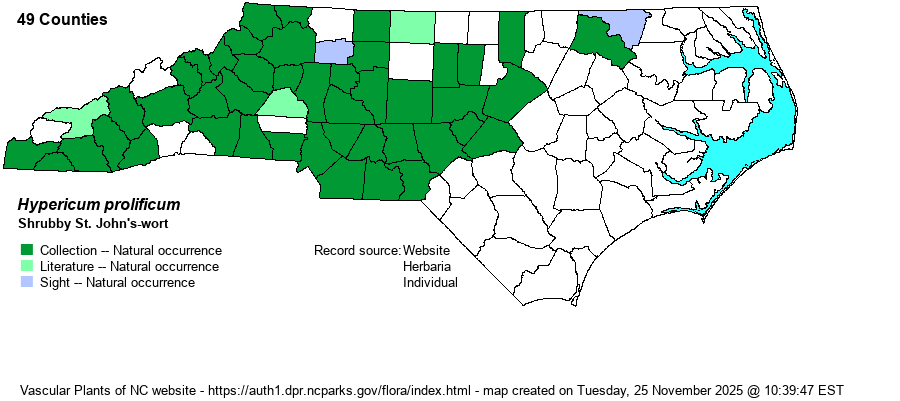| Author | L. | |
| Distribution | Present over most of the Mountains and Piedmont, and barely ranging into the western edge of the Coastal Plain. Absent from the Sandhills.
Mainly north of the state, ranging from southeastern Canada south to northern GA and barely to eastern TX. It is scarce in the Atlantic and Gulf Coastal Plains.
| |
| Abundance | Fairly common in the Mountains and locally in most of the Piedmont, but seldom common anywhere; seems to be less common in parts of the southern Mountains. Rare in the Coastal Plain portion of the range. | |
| Habitat | This is a species mostly of rocky forests, slopes, and other fairly dry forested conditions. It can grow around rock outcrops, and also in seepages, at least on forested slopes. It rarely grows in bogs and damp forests. Thus, it often grows in the same, or similar, habitats as does H. densiflorum. | |
| Phenology | Blooms and fruits from June to August. | |
| Identification | This is a medium-sized deciduous shrub that is widely-branched are reaches about 3-4 feet tall. Its opposite leaves are narrowly elliptic, with revolute margins and reach about 1.5-2 inches on average. Its leaves average about 8-10 mm (0.3-0.4-inch) wide, considerably wider than those of H. densiflorum. And, in bloom this species has only 3-7 flowers per cluster, as opposed to 7 or more flowers per cluster in H. densiflorum. Both species are quite attractive with the large number of sizable yellow flowers, but as with many shrubs of forests, individuals are more often seen in leaf than in flower. For whatever reason, when one stumbles onto a population of these shrubs on a rocky and often rather sterile forested hillside, they seem to be out of place, almost like an exotic, escaped species. | |
| Taxonomic Comments | Older references sometimes referred to this species as H. spathulatum.
| |
| Other Common Name(s) | None | |
| State Rank | S4 | |
| Global Rank | G5 | |
| State Status | | |
| US Status | | |
| USACE-agcp | FAC link |
| USACE-emp | FACU link |

